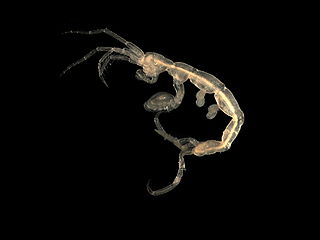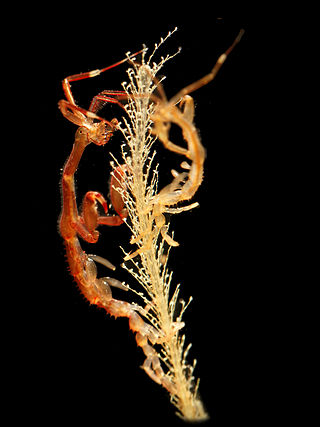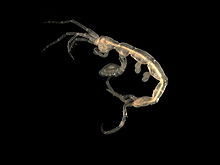
Amphipoda is an order of malacostracan crustaceans with no carapace and generally with laterally compressed bodies. Amphipods range in size from 1 to 340 millimetres and are mostly detritivores or scavengers. There are more than 9,900 amphipod species so far described. They are mostly marine animals, but are found in almost all aquatic environments. Some 1,900 species live in fresh water, and the order also includes the terrestrial sandhoppers such as Talitrus saltator and Arcitalitrus sylvaticus.

Eucarida is a superorder of the Malacostraca, a class of the crustacean subphylum, comprising the decapods, krill, and Angustidontida. They are characterised by having the carapace fused to all thoracic segments, and by the possession of stalked eyes.

Caprellidira is a parvorder of marine crustaceans of the infraorder Corophiida. The group includes skeleton shrimps (Caprellidae) and whale lice (Cyamidae).

Gammaridea is one of the suborders of the order Amphipoda, comprising small, shrimp-like crustaceans. Until recently, in a traditional classification, it encompassed about 7,275 (92%) of the 7,900 species of amphipods described by then, in approximately 1,000 genera, divided among around 125 families. That concept of Gammaridea included almost all freshwater amphipods, while most of the members still were marine.
Phliantidae is a family of isopod-like amphipod crustaceans chiefly from the southern hemisphere.
Paracalliopiidae is a family of amphipods, containing the following genera:

Photis is a genus of amphipod crustaceans, containing the following species:

Amaryllididae is a family of marine benthic amphipods found throughout the southern hemisphere. These smooth, laterally compressed amphipods can be distinguished by the accessory setal row of the mandible having a distal tuft. It was first described in 2002 by James K. Lowry and Helen E. Stoddart. It contains the following genera:

Asellota is a suborder of isopod crustaceans found in marine and freshwater environments. Roughly one-quarter of all marine isopods belong to this suborder. Members of this suborder are readily distinguished from other isopods by their complex copulatory apparatus. Other characteristics include six-jointed antennal peduncle, the styliform uropods, the fusion of pleonites 5, 4 and sometimes 3 to the pleotelson, and absence of the first pleopod in females.
Phylogeny of Malacostraca is the evolutionary relationships of the largest of the six classes of crustaceans, containing about 40,000 living species, divided among 16 orders. Its members display a great diversity of body forms. Although the class Malacostraca is united by a number of well-defined and documented features, which were recognised a century ago by William Thomas Calman in 1904, the phylogenetic relationship of the orders which compose this class is unclear due to the vast diversity present in their morphology. Molecular studies have attempted to infer the phylogeny of this clade, resulting in phylogenies which have a limited amount of morphological support. To resolve a well-supported eumalacostracan phylogeny and obtain a robust tree, it will be necessary to look beyond the most commonly utilized sources of data.

Caprella mutica, commonly known as the Japanese skeleton shrimp, is a species of skeleton shrimp. They are relatively large caprellids, reaching a maximum length of 50 mm (2.0 in). They are sexually dimorphic, with the males usually being much larger than the females. They are characterized by their "hairy" first and second thoracic segments and the rows of spines on their bodies. Body color ranges from green to red to blue, depending on the environment. They are omnivorous highly adaptable opportunistic feeders. In turn, they provide a valuable food source for fish, crabs, and other larger predators. They are usually found in dense colonies attached to submerged man-made structures, floating seaweed, and other organisms.

Corophiidira is a parvorder of marine amphipod crustaceans in the infraorder Corophiida. In a previous classification, this taxon was treated as an infraorder and was then itself called Corophiida.

Caprelloidea is a superfamily of marine crustaceans in the order Amphipoda. It includes "untypical" forms of amphipods, such as the skeleton shrimps (Caprellidae) and whale lice (Cyamidae). The group was formerly treated as one of the four amphipod suborders, Caprellidea, but has been moved down to the superfamily rank by Myers & Lowry after phylogenetic studies of the group, and is now contained in the infraorder Corophiida of the suborder Senticaudata. The group includes the following families.

Senticaudata is one of the four suborders of the crustacean order Amphipoda. It includes some 5000 species, which is more than 50% or the currently recognized amphipod diversity.

Caprella unica is a species of skeleton shrimp in the genus Caprella within the family Caprellidae. The larvae are plankton-like. They are relatively small, with two large and two small antennae. They only live in the sea, and are widely found in Cape Cod, Maine and Newfoundland.
Bougisia is a genus of plankton in the sub-order Hyperiidea – a type of so-called "hyperid" amphipoda. The genus Bougisia is the only subordinate taxon in the monotypic family Bougisidae. The genus Bougisia is also monotypic, being represented by the single species, Bougisia ornata. This species lives as plankton in tropical and sub-tropical salt water. Hyperiidea species normally have a physique that differs from other types of amphipod.
Iphigenellidae is a freshwater family of amphipods in the superfamily Gammaroidea. It is found in the Ponto-Caspian region, which encompasses the Black, Azov, and Caspian Seas.

Maeridae is a family of marine amphipods, which was first described by Taudl Krapp-Schickel in 2008.
James Kenneth Lowry was a zoologist specialising in amphipods.
Lauren Elizabeth Hughes is an Australian carcinologist and curator. She specialises in the study of amphipods.












